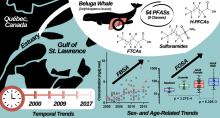| Title | Untargeted Screening and Distribution of Organo-Bromine Compounds in Sediments of Lake Michigan. |
| Publication Type | Journal Article |
| Year of Publication | 2016 |
| Authors | Peng, H, Chen, C, Cantin, J, Saunders, DMV, Sun, J, Tang, S, Codling, G, Hecker, M, Wiseman, S, Jones, PD, Li, A, Rockne, KJ, Sturchio, NC, Giesy, JP |
| Journal | Environ Sci Technol |
| Volume | 50 |
| Issue | 1 |
| Pagination | 321-30 |
| Date Published | 2016 Jan 05 |
| ISSN | 1520-5851 |
| Keywords | Bromine Compounds, Environmental Monitoring, Geologic Sediments, Halogenated Diphenyl Ethers, Hydrocarbons, Brominated, Lakes, Michigan, Water Pollutants, Chemical |
| Abstract | Previously unreported natural and synthetic organo-bromine compounds (NSOBCs) have been found to contribute more than 99% of total organic bromine (TOB) in environmental matrices. We recently developed a novel untargeted method (data-independent precursor isolation and characteristic fragment, DIPIC-Frag) and identified ∼2000 NSOBCs in two sediments from Lake Michigan. In this study, this method was used to investigate the distributions of these NSOBCs in 23 surficial samples and 24 segments of a sediment core from Lake Michigan. NSOBCs were detected in all 23 surficial samples and exhibited 10- to 100-fold variations in peak abundance among locations. The pattern of distributions of NSOBCs was correlated with depth of the water column (r(2) = 0.61, p < 0.001). Hierarchical cluster analysis showed that sediments in close proximity exhibited similar profiles of NSOBCs. Distributions of NSOBCs in 24 segments of a sediment core dated from 1766 to 2008 were investigated, and samples from similar depths exhibited similar profiles of NSOBCs. NSOBCs were grouped into four clusters (soft-cluster analysis) with different temporal trends of abundances. 515 and 768 of the NSOBCs were grouped into cluster 1 and cluster 3 with increasing temporal trends, especially since 1950, indicating that abundances of these compounds might have been affected by human activities. |
| DOI | 10.1021/acs.est.5b04709 |
| Alternate Journal | Environ. Sci. Technol. |
| PubMed ID | 26618527 |
Environmental Chemical Biology

